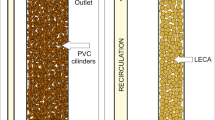Abstract
A bacterial biofilm, capable of mineralising a technical mixture of cis- and trans-1,3-dichloropropene (DCPE), was enriched on the biomedium side of an extractive membrane biofilm reactor (EMBR). The membrane separates the biomedium from the industrial waste water, in terms of pH, ionic strength and the concentration of toxic chemicals. The biofilm, attached to a silicone membrane, is able to mineralise DCPE after its diffusion through the membrane. Five bacterial strains with degradation capabilities were isolated from the metabolically active biofilm and further investigated in batch experiments. Two of them, Rhodococcus erythropolis strains EK2 and EK5, can grow with DCPE as the sole carbon source. Pseudomonas sp. EK1 utilises cis-3-chloroallylalcohol and cis-3-chloroacrylic acid, whereas the metabolite trans-3-chloroacrylic acid represents a dead-end product of the pathway of this strain. The other two strains, Delftia sp. EK3 and EK4, although unable to grow with DCPE as the carbon source, can transform DCPE and its upper-pathway intermediates at reasonable conversion rates. They may represent helper functions of the biofilm consortium, which mineralised up to 12.5 mmol DCPE per hour per gram of biomass protein. Higher feed rates in the EMBR (up to 15 mmol per hour per 100-l bioreactor volume) and shock loads corresponding to concentrations up to 1.8 mmol l−1 led to a significant increase in the freely floating bacterial biomass in the reactor medium (OD546= 0.2). At the standard operating feed rate of 1.8 mmol h−1, the free biomass concentration was very low (OD546= 0.04).
Similar content being viewed by others
Author information
Authors and Affiliations
Additional information
Received: 23 April 1999 / Received revision: 1 July 1999 / Accepted: 5 July 1999
Rights and permissions
About this article
Cite this article
Katsivela, E., Bonse, D., Krüger, A. et al. An extractive membrane biofilm reactor for degradation of 1,3-dichloropropene in industrial waste water. Appl Microbiol Biotechnol 52, 853–862 (1999). https://doi.org/10.1007/s002530051603
Issue Date:
DOI: https://doi.org/10.1007/s002530051603




